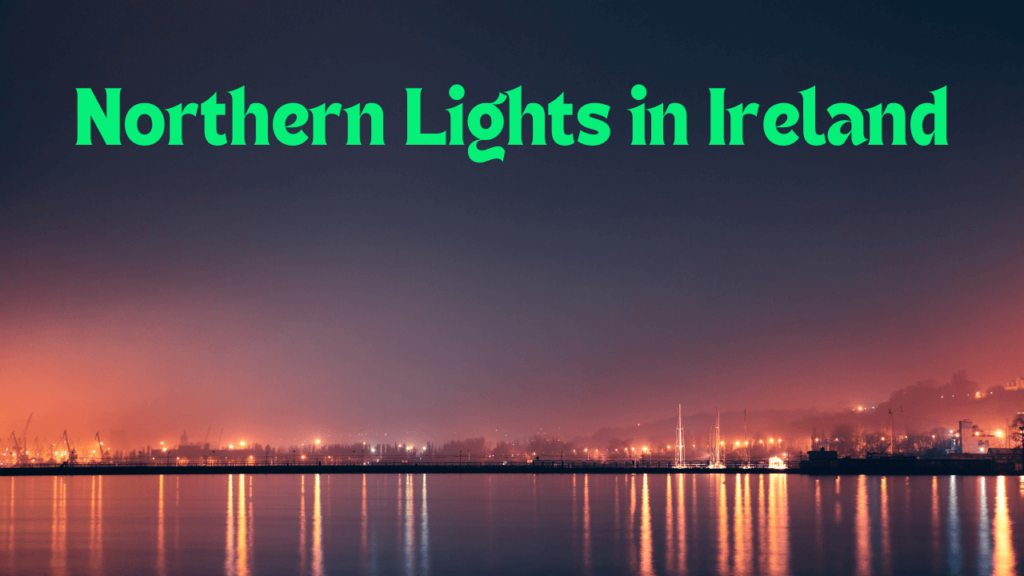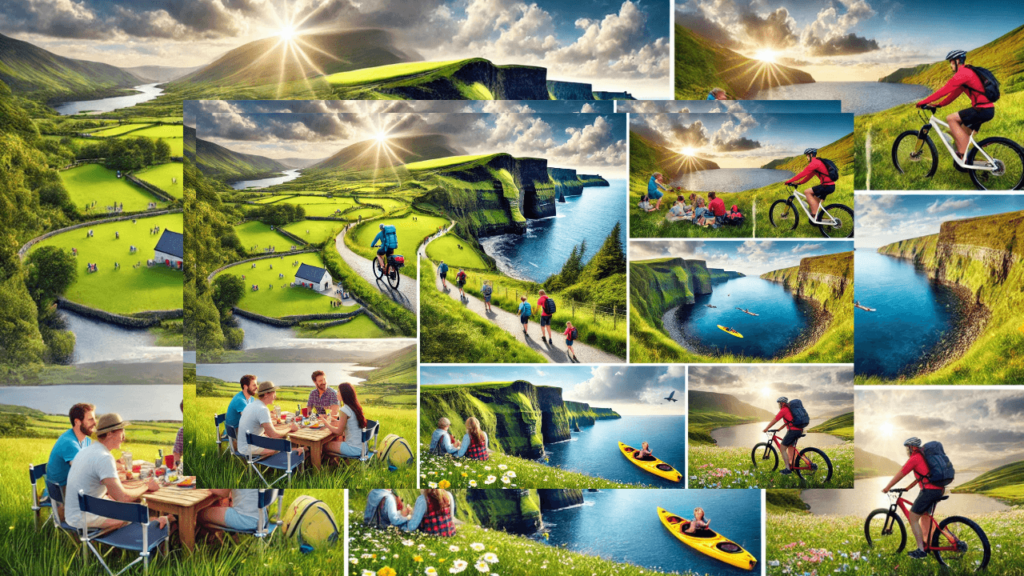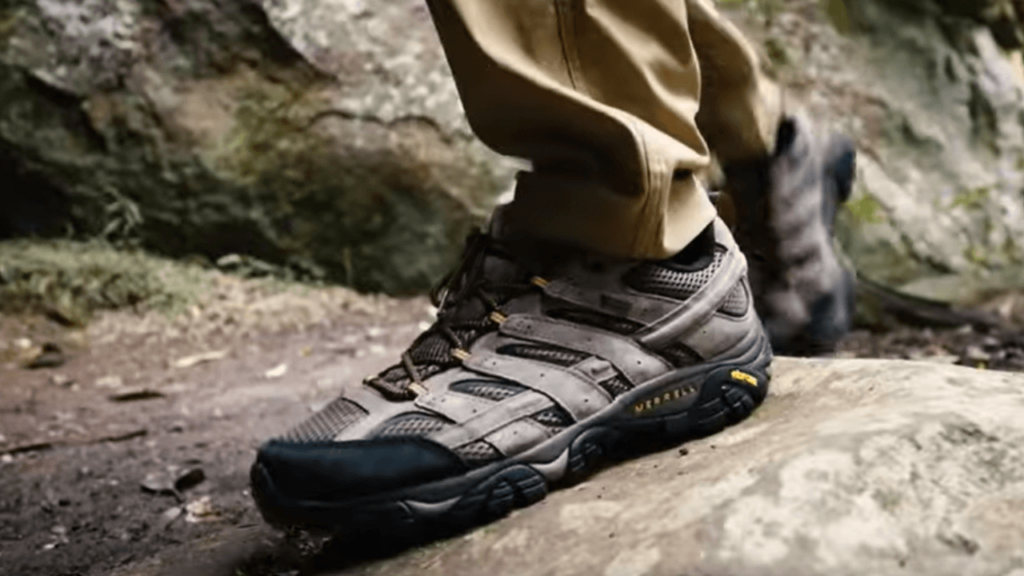The Northern Lights, also known as the Aurora Borealis, are one of the most mesmerizing natural displays on Earth. While this stunning light show is often associated with countries like Norway, Sweden, and Iceland, Ireland offers an excellent opportunity to witness this wonder.
In this post, we’ll explore where and when you can see the Northern Lights in Ireland, the science behind them, and tips to make the most of your experience.
1. What Are the Northern Lights?
The Northern Lights are a natural light display caused by the interaction of solar wind with Earth’s magnetic field. Here’s how it happens:
- Solar Wind: The sun releases charged particles that travel through space.
- Magnetic Field: When these particles reach Earth, they collide with atoms in the atmosphere, releasing energy that creates colorful light.
- Colors of the Aurora: The colors can range from green to pink to red, yellow, and purple, depending on the type of gas the particles interact with.
Key Facts About the Northern Lights:
- Best Time to See Them: Autumn to spring, especially between September and March.
- Best Locations: Close to the magnetic poles (North Pole or South Pole).
- Main Colors: Green (most common), purple, pink, and red.
2. Can You See the Northern Lights in Ireland?
Yes! While Ireland is not as far north as countries like Iceland, it is still possible to see the Northern Lights under the right conditions. Northern Ireland, especially areas in the north and northwest, offers the best chances to witness this natural phenomenon.
Factors That Make It Possible to See the Northern Lights in Ireland
- Geomagnetic Activity
- The intensity of the aurora is measured by the KP index (a scale from 0 to 9).
- A KP index of 4 or higher is usually required for the Northern Lights to be visible in Ireland. During strong geomagnetic storms (KP 5+), the aurora becomes visible farther south.
- Dark Skies
- Light pollution significantly affects visibility. Rural and remote areas with minimal artificial light are essential for a good view.
- Clear Weather
- Ireland’s weather is often cloudy and rainy, but clear skies are crucial for seeing the lights. Winter months generally provide better chances due to longer nights and occasional clear skies.
- Location
- Areas in northern and northwestern Ireland are closer to the auroral oval and have the least light pollution, making them the best spots for aurora watching.
Best Locations in Ireland to See the Northern Lights:
- Northern Ireland
- County Antrim: Especially around the Giant’s Causeway and the Dark Hedges.
- County Down: Areas like Murlough Bay are ideal.
- Republic of Ireland
- County Donegal: Known for its dark skies, especially in areas like Malin Head.
- County Mayo: Achill Island offers a great vantage point.
- County Kerry: Dingle Peninsula can provide clear skies for viewing.
When Is the Best Time to See the Northern Lights in Ireland?
The Northern Lights are most commonly visible in Ireland during specific times of the year and under certain conditions.
Seasonal Viewing
- Autumn to Spring: The best months are from September to March, when nights are longer and darker.
- Winter Months: December and January have the longest nights, increasing your viewing opportunities.
Time of Night
- The best time to view the Northern Lights is between 10:00 PM and 2:00 AM. These hours provide the darkest conditions.
Solar Cycles
- Solar activity follows an 11-year cycle, with the most active phase (solar maximum) offering more frequent auroras. The current cycle is expected to peak in 2025, increasing the likelihood of sightings in Ireland.
3. How to Increase Your Chances of Seeing the Northern Lights in Ireland
While seeing the Northern Lights is not guaranteed, there are several ways to increase your chances:
Tips for a Better Viewing Experience:
- Check the Aurora Forecast:
- Websites and apps like AuroraWatch or SpaceWeatherLive can help you monitor solar activity and predict when auroras are most likely.
- Find Dark Sky Locations:
- Avoid light pollution by heading to remote, rural areas or national parks.
- Go High and Far North:
- The higher your altitude and the further north you are, the better the chances.
- Be Patient:
- The Northern Lights are unpredictable, so give yourself plenty of time to wait for the display.
- Plan for Winter:
- During the winter months, the nights are longer, which gives you a greater chance of seeing the lights.
Best Months for Northern Lights Viewing:
| Month | Likelihood of Seeing Northern Lights |
|---|---|
| September | Moderate |
| October | High |
| November | High |
| December | Very High |
| January | Very High |
| February | High |
| March | Moderate |
4. The Science Behind the Northern Lights
The Northern Lights occur due to solar winds, which are streams of charged particles from the sun. These particles interact with Earth’s magnetic field and atmosphere, causing atoms to release energy in the form of light. Here’s a simplified breakdown:
- Step 1: Solar Wind: The sun emits charged particles.
- Step 2: Earth’s Magnetic Field: These particles are directed toward the poles by Earth’s magnetic field.
- Step 3: Atmospheric Reaction: As the particles collide with atoms in the atmosphere (mostly oxygen and nitrogen), they release light in various colors.
Common Misconceptions About the Northern Lights:
- Myth 1: Northern Lights Can Be Seen Every Night: It’s not guaranteed every night, as it depends on solar activity and weather conditions.
- Myth 2: They Are Only Visible in the Far North: Though they are most commonly seen in Arctic regions, strong solar activity can make them visible further south, including Ireland.
5. What to Do If You See the Northern Lights in Ireland?
Seeing the Northern Lights is a once-in-a-lifetime experience, so make sure to capture it. Here are a few tips:
How to Photograph the Northern Lights:
- Use a Tripod: To avoid blurry photos, set your camera on a tripod.
- Manual Settings: Adjust the ISO, exposure time, and aperture manually to get the best shot.
- Long Exposure: The Northern Lights are faint, so use a long exposure time (between 10-20 seconds).
- Wide-Angle Lens: A lens between 18-24mm will allow you to capture the vast sky and the lights.
What to Bring for Northern Lights Viewing:
- Warm Clothes: The best views are often in cold weather, so dress in layers.
- Snacks and Drinks: Keep yourself energized for the wait.
- Camera Gear: Don’t forget your camera, tripod, and extra batteries (cold weather drains them fast!).
6. Northern Lights Tours in Ireland
While you can venture out on your own, there are several guided tours that can take you to prime Northern Lights viewing spots in Ireland.
Top Northern Lights Tour Operators in Ireland:
- Wild Atlantic Way Tour (County Donegal)
- Dark Sky Discovery Tours (County Antrim)
- Celtic Horizon Tours (County Mayo)
What’s Included in a Tour:
- Expert guides who know the best spots and weather conditions.
- Transportation to remote, light-pollution-free locations.
- Photography assistance to capture the Northern Lights.
7. Is it Worth the Trip to See the Northern Lights in Ireland?
Absolutely! While the Northern Lights in Ireland may not be as common or as dramatic as in places closer to the Arctic Circle, the experience is still awe-inspiring and worth the effort. The fact that you can combine a trip to see the Northern Lights with exploring Ireland’s other natural wonders makes it an unforgettable journey.
Conclusion
The Northern Lights are a spectacular natural phenomenon that can sometimes be seen in Ireland. While there’s no guarantee, the right time, location, and conditions can offer an unforgettable experience. By planning ahead, using local resources, and being patient, you can greatly increase your chances of seeing the magical Aurora Borealis.
If you’d like further detail on any specific section, feel free to ask!

Hi, I’m Tanvir, the founder and author of Explore Ireland Now. With a deep love for Ireland and its rich culture, history, and landscapes, I created this site to share everything that makes this beautiful country worth exploring. Whether you’re a local looking for hidden gems or a traveler planning your next adventure, I provide insightful guides, tips, and recommendations to help you experience Ireland to the fullest.
From stunning landscapes to vibrant cities and quaint villages, Ireland is full of wonders waiting to be discovered. Through my personal experiences and research, I aim to bring you the most up-to-date information and inspiration for your journey.
Thank you for visiting Explore Ireland Now—I hope my content helps you uncover all that this incredible country has to offer! If you have any questions or need travel advice, feel free to reach out.



